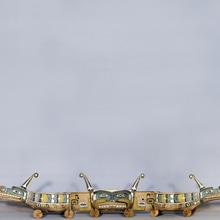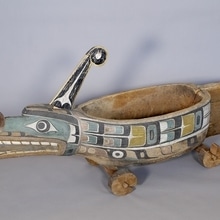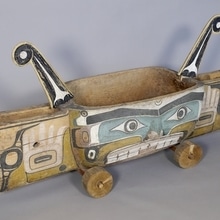House Feast Dish
MOA: University of British Columbia
A4147 a-i
Wooden feast dish (parts a-i) consisting of three large, deeply carved bowls (parts a-c), the whole forming a supernatural creature called a sisiutl. The bowls each sit of 2 sets of wheels that are loosely joined by mortise and tenon arrangements. The two end bowls (parts a and c) each depict the head and body of the serpent with a large protruding snout, carved eyes, ears and bared teeth. The middle bowl (part b) has a carved and painted human-like face on the sides, with two hands on the joins. Two large ladles (parts d-e) balance in the mouths of the sisuitl, projecting outward like tongues, held in by their handles. On top of the heads are four horn-like extensions (parts f-i), one at each end and two in the middle section. The bowl is painted with black, white, green, red and yellow design elements. There are holes in the overlapping slotted pieces for dowels (not incl. with dish).
-
Cultural Context
ceremonial; potlatch; status; privileges
-
History Of Use
Large feast dishes were used primarily to hold food served to guests at winter dance ceremonies and potlatches, as well as on other important social occasions. They also were symbols of wealth and prestige. The figures represented on feast dishes were family crests and privileges. Important feast dishes were named.
-
Iconographic Meaning
Sisiyutl is a supernatural serpent, often represented with two heads, and is associated with wealth and power. It features three horned faces, deeply carved bowls, and huge ladles as tongues.
-
Narrative
The dish was commissioned in the early 20th century by Sewid Smith, the Ławit̓sis chief at Kalugwis, on Turnour Island. His son, Peter (Sewidanakwila), recalled that it only ever held gifts of sugar, which were distributed by the chief and his family to their guests. This dish privilege was shown at a potlatch hosted by Alex Smith, Peter Smith's nephew.
- Type of Item dish
- Culture Kwakwaka'wakw
- Material paint, red cedar wood, metal
- Manufacturing Technique carved, painted
- Measurements height 72.5 cm, width 57.4 cm, depth 219.8 cm (part a) height 60.8 cm, width 60.7 cm, depth 198.6 cm (part b) height 71.1 cm, width 54.3 cm, depth 209.6 cm (part c) height 14.5 cm, width 29.3 cm, depth 128.6 cm (part d) height 14.5 cm, width 30.8 cm, depth 124.6 cm (part e) height 56.4 cm, width 16.8 cm, depth 1.4 cm (part f) height 1.0 m, width 0.6 m, depth 7.0 m (overall)
- Creator Charlie James
- Previous Owner Peter S. Smith, Sewid Smith, Alice Smith
- Received from H. R. MacMillan, Alice Smith
- Made in British Columbia
- Collected in Turnour Island, Kalugwis
- Creation Date during 1907
- Ownership Date before May 1951
- Acquisition Date during May 1951
- Condition fair
- Accession Number 1969/0001



